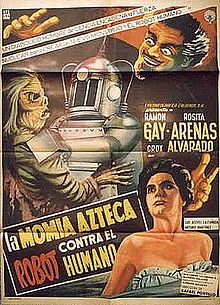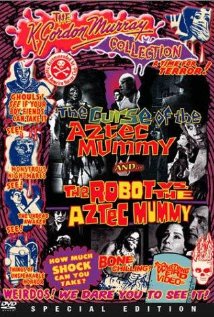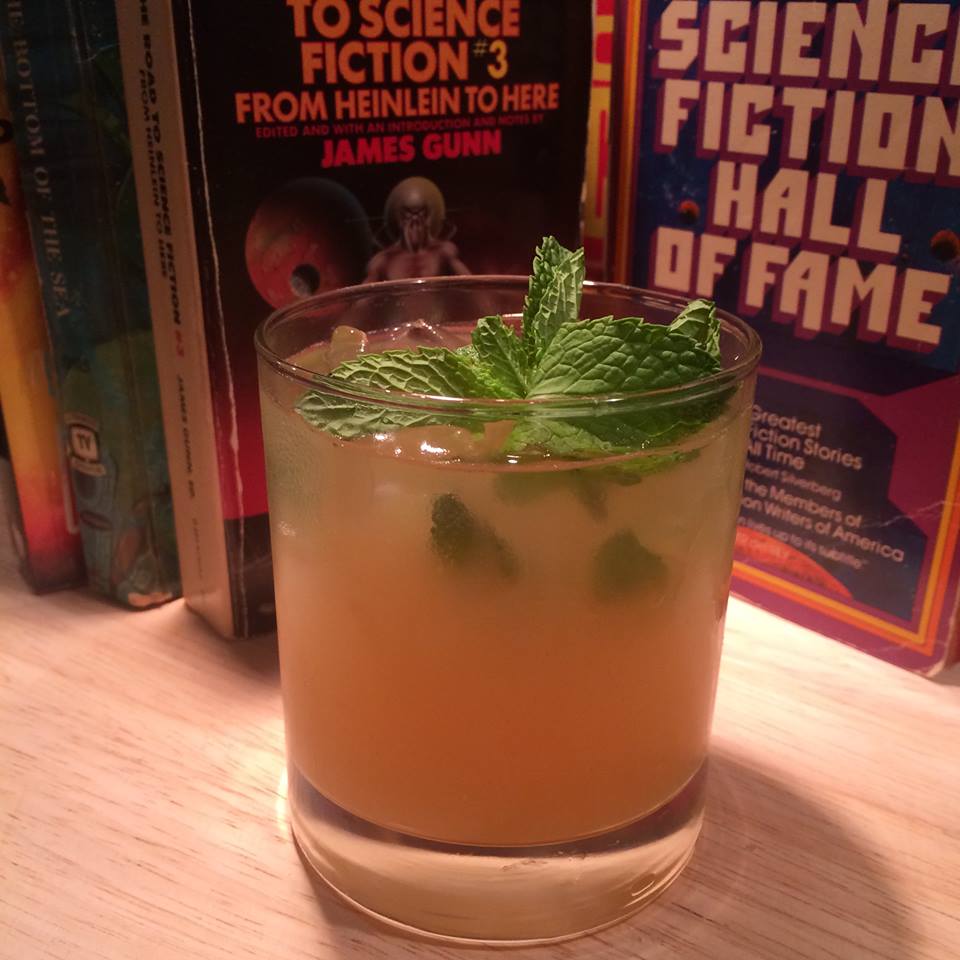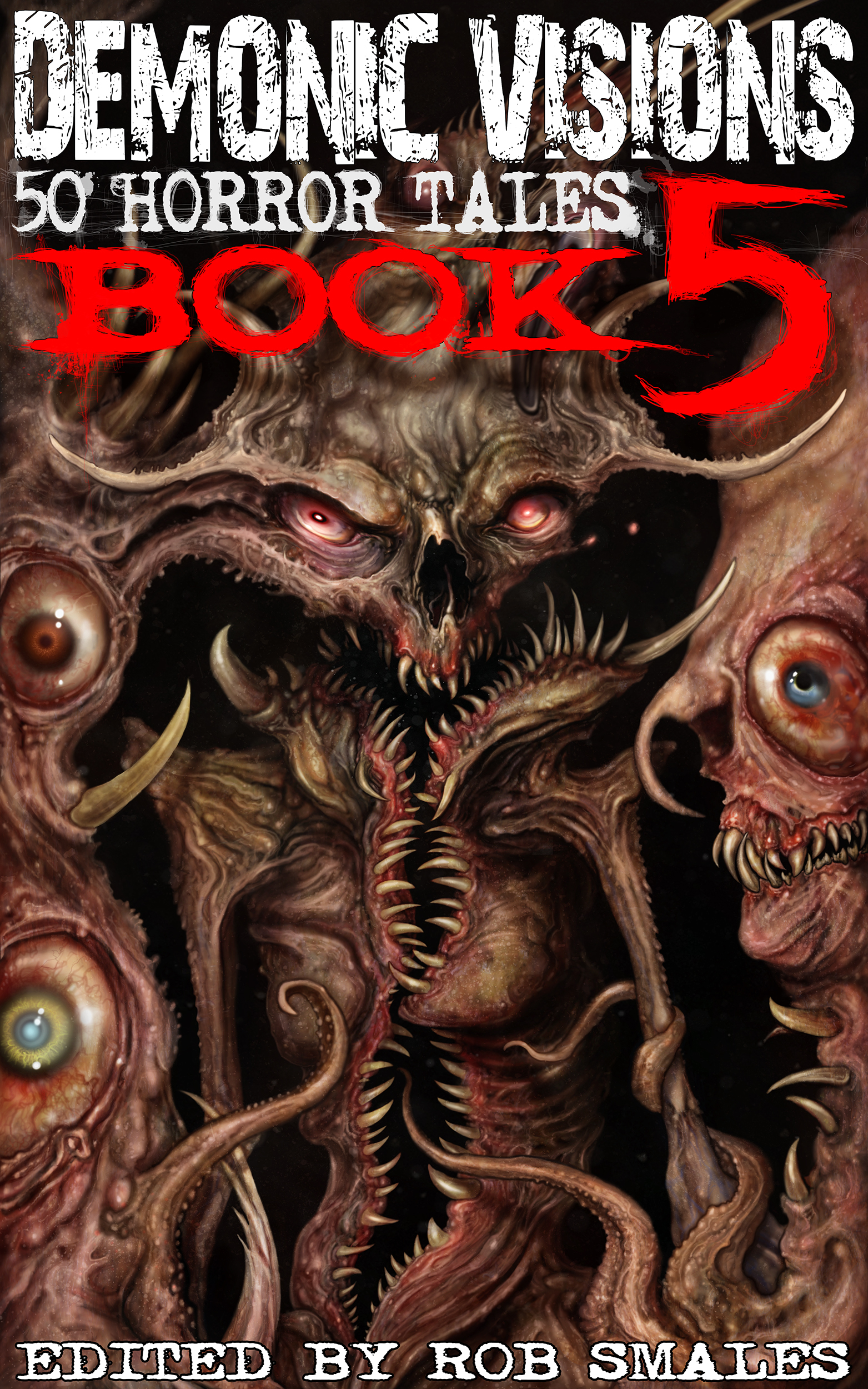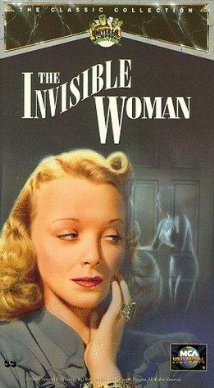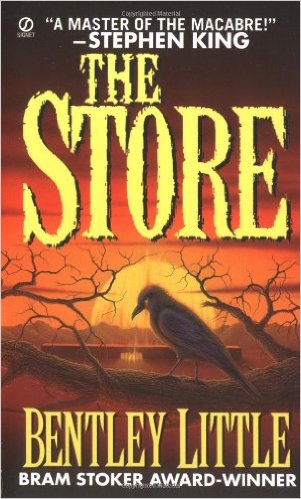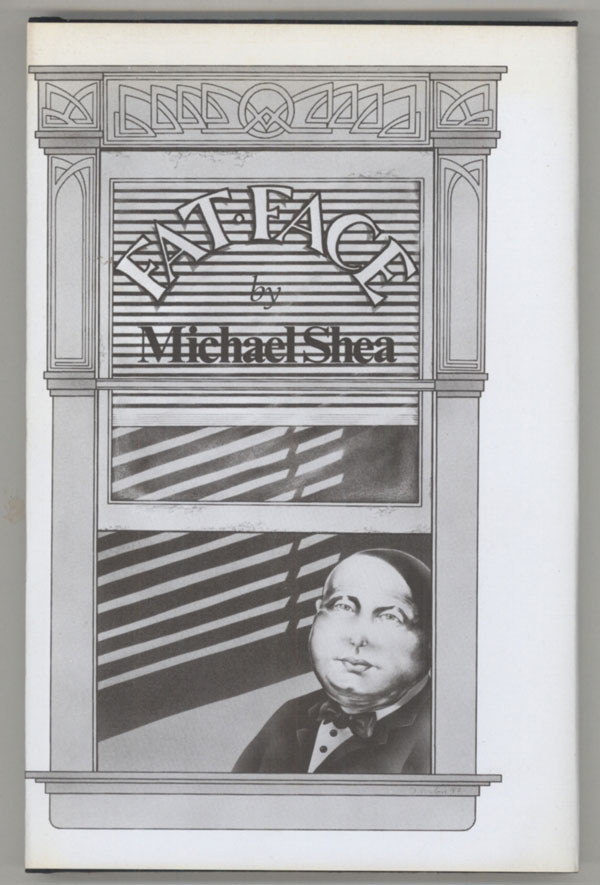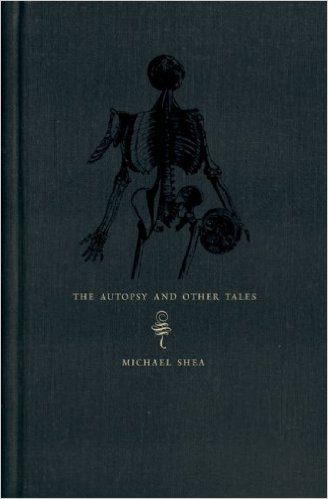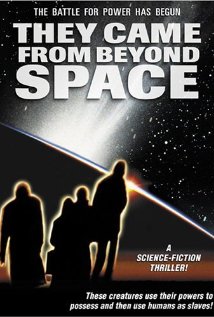I’ll just let this image speak for itself: the highest-resolution color image of Pluto yet. More mind-blowing pics available at NASA’s New Horizons Image Gallery.
Monthly Archives: September 2015
Forgotten Films: The Robot Versus the Aztec Mummy (1958)
By Scott A. Cupp
This is the 135th my series of Forgotten, Obscure or Neglected Films
Some three and a half years ago or so, I reviewed The Aztec Mummy as the 16th Forgotten Film in my series of reviews. TCM recently broadcast the third in the series so I decided, “What the heck? Let’s do the third one this time. Nobody will know the difference, particularly since the second one ignored a lot of the continuity anyway.”
The film begins with a lengthy recap of the first film where Dr. Eduardo Almada (Ramon Gay) and his wife Flor (Rosa Arenas) reprise their roles as a scientist who hypnotically regresses his wife to relive her life as an Aztec priestess Xochitl who defied the gods with her lover Popoca (Angel Di Stefani) in defiance of the gods. Popoca is turned into a living mummy who guards the tomb of Xochitl and her golden breastplate and bracelet, which tell people how to find an ancient Aztec treasure.
In the original film, the evil Bat, a murderous pseudonym used by Dr. Krupp (Luis Aceves Castañeda) tries to steal the treasure but is defeated by the mummy. Well, here he is back again, having escaped certain death just as if he was in a ’30s serial. Here he hypnotizes Flor and has her lead him to the mummy because she can mentally “hear” him. She runs around in a nightgown while leading Dr. Krupp, of course.
The Bat is intent on building a human robot (Adolfo Rojas) with intelligence to fight the Mummy and handle the theft of the breastplate and bracelet because he knows he cannot beat the mummy by himself. The robot looks like a large silver box and some pipes thrown together with a human head inside. Or, as one reviewer said, something a couple of grips threw together on their lunch break.
They find the mummy in a mausoleum and bring about the fight promised in the tile when the breastplate and bracelet are removed. The fight is somewhat short since the mummy doesn’t talk and the robot doesn’t either. The robot doesn’t stand a chance against Aztec magic and Flor gives the goods back to the mummy and tells him to guard them well and go back to his sleep.
Thankfully, the film is short, clocking in at 65 minutes. Short but not too sweet. It was the perfect thing to watch after seeing my beloved Texas Longhorns lose another game in the final minute to a special team’s kicking error.
While the film was made in Mexico and in Spanish, it was brought to the U.S. by entrepreneur K. Gordon Murray, where it was dubbed (badly) in English. The dubbing apparently had little to do with the original story. The dubbing led to this story being presented by the Mystery Science Theater 3000 crew in 1989 as their second offering in their first season on the Comedy Channel.
I love movie soundtracks but this one is intrusive and annoying so you can skip this.
So, if you’re in the mood for a bad movie, this is one. It’s got all the cheesy parts of the first film as well as a robot and extended flashbacks. The films are pretty readily available either individually or as a collection. The set of three are under $20.
Try them. You may like them. If you do, please consult your mental health professionals.
Series organizer Todd Mason hosts more Tuesday Forgotten Film reviews at his own blog and posts a complete list of participating blogs.
Cocktail Hour: The Spacer (Inspired by Samuel Delaney’s “Aye, and Gomorrah…”)
When I first read Samuel Delaney’s “Aye, and Gomorrah…” as a teenager, I had no idea what to make of it.
Most of the sf I’d read up to that point was about big ideas, big action and big conflict. People saving or destroying planets, besting alien adversaries and exploring new dimensions. And here was a short story deemed important enough to win the 1967 Nebula award that was simply about a woman propositioning the protagonist for sex — or something like sex.
What was I missing? Turned out, a lot.
In Delaney’s story, interstellar travelers — dubbed “Spacers” — are neutered before puberty to null the effects of the radiation they encounter during their travels. They grow into sterile, androgynous adults whose original sex is the subject of guessing games. Enter the “frelks,” a group of fetishists aroused by the Spacers, primarily it’s suggested, because the sexless space travelers are unattainable.
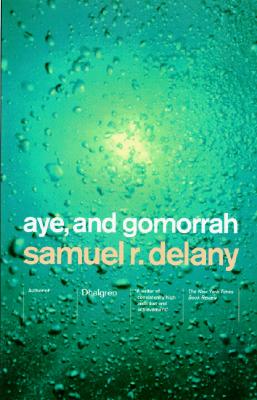 The story begins with a group of Spacers on a Kerouac-esque road trip that whisks them from France to Mexico to Texas to Turkey, drawing gawks from the populace along the way. We learn the Spacers are hustling for frelks, seeking compensation for their desirable androgyny and sterility. We also get the sense that while they’re superficially respected by Earth people, they’re still lonely outsiders.
The story begins with a group of Spacers on a Kerouac-esque road trip that whisks them from France to Mexico to Texas to Turkey, drawing gawks from the populace along the way. We learn the Spacers are hustling for frelks, seeking compensation for their desirable androgyny and sterility. We also get the sense that while they’re superficially respected by Earth people, they’re still lonely outsiders.
About midway through the story, the unnamed Spacer protagonist ends up making eye contact with a pretty Turkish student, who invites him to her apartment. The rest of the story plays out largely in dialogue as they spar over the Turkish woman’s interest in Spacers and she tries to convince her pickup to stay, even though she can’t come up with any lire to make it worthwhile.
Delaney, who is gay, points out the story was “written three years before Stonewall and half a dozen years before anyone was aware there might even be a disease like AIDS.” It’s clearly a commentary on what it means to be a sexual other, and it makes the powerful argument that sexuality is not a choice — an idea not widely accepted 50 years ago.
‘“You don’t choose your perversions,”‘ the Turkish student tells the Spacer. ‘”You have no perversions at all. You’refree of the whole business. I love you for that, Spacer. My love starts with the fear of love. Isn’t that beautiful? A pervert substitutes something unattainable for ‘normal’ love: the homosexual, a mirror, the fetishist, a shoe or a watch or a girdle.”’
The story works in part on the strength of the prose, which whips along with a playful rhythm. Delaney doesn’t beat us over the head with long-winded explanations about who the Spacers or frelks are and how this future society works. We pick up those details gradually, through dialogue and action, as the story unfolds.
Even though its powerful message about sexuality not being a choice may not be as revelatory today (for many of us, anyway), “Aye, and Gomorrah…” has additional resonance because it recognizes that human sexuality evolves with technological change. Who’d have thunk back in 1966, for example, that people would be so willing to commit mutual masturbation in front of computer screens halfway around the globe? And consider the number of fetishes — from latex clothing to extreme body modifications — that are the outgrowth of technological advances.
I don’t know about you, but all that analysis has left me with a powerful thirst. May I present this week’s cocktail, the Spacer?
The Spacer riffs on the fetishized outsiders of “Aye, and Gomorrah” by giving exotic flavors a boozy boost. The ingredients also give a nod to the story’s Turkish, Mexican and Texan settings. The tequila and tamarindo are a perfect border combination, sweetened by the pineapple juice, and the mint spins us halfway around the world to Istanbul’s Flower Passage.
THE SPACER
2 oz. reposado tequila
2 oz. fresh pineapple juice
2 oz. or more of chilled tamarindo (tamarind soda available at most Latin American markets)
Fresh mint leaves
1/2 tsp sugar
Muddle six to eight mint leaves with the sugar in the bottom of a cocktail glass. Fill the glass with ice and pour in the tequila and pineapple juice. Still until condensation appears on the outside of the glass and top with the tamarindo. Garnish with another sprig of fresh mint.
FORGOTTEN BOOK: Academia Waltz and Other Profound Transgressions by Berke Breathed (2015)
This is the 158th in my series of Forgotten Books.
Berke Breathed is one of my favorite cartoonists. I discovered Bloom County in the early 1980’s and followed the exploits of Steve Dallas, Milo, Opus, Bill the Cat and the county’s other denizens. It joined Doonesbury, The Far Side, Calvin and Hobbs, and Peanuts among my daily favorites. I read whatever was on the comics page, be it Mandrake, Brenda Starr, Dick Tracy, Mary Worth, Apartment 3-G, or Bizarro. I have no taste. I like comics.
But Bloom County was special. Recently IDW Publishing went to the back-breaking depths to provide all of the Bloom County, Outland and Opus strips (daily when they were around and Sunday) in a series of hardcover matched volumes. This was wonderful! Many daily strips were a little too topical for his publisher when the collections were being published so if I did not see that particular daily strip, I had missed them. Not so any more.
But Bloom County did not spring fully formed from Breathed’s mind. Like me, Breathed attended the University of Texas (imagine The Eyes of Texas in the background, burnt orange, and a Hook’em Horns held high). I bleed burnt orange. The six years I spent there were among the best in my life. I made friends I still see today and managed to form something approaching a human being from the lump of geeky clay that walked onto that campus 45 years ago.
Like Garry Trudeau at Yale before him, Breathed did a daily cartoon strip The Academia Waltz for the campus paper, The Daily Texan. I did not see these, as I was gone by the time he started publishing there and in the local newspaper the Austin American Statesman. While still at the University, Breathed self-published two volumes of his work, The Academia Waltz and The Academia Waltz Bowing Out. They had very small print runs and were highly coveted and hoarded by their owners. I had seen both and read them. In 35 years, I had found exactly one (1!) copy of the second book for sale at an affordable price and none of the first.
I owned all the other IDW Breathed publications (the five volumes of Bloom County, the Outland volume and the Opus volume). So when Academia Waltz and Other Profound Disasters was offered, my finger twitched and hit the Buy Now button.
These are certainly the fledgling efforts of a young cartoonist reacting to life around him. They center around some campus politics and sports (Earl Campbell is a featured sacred cow being barbecued). But you can see where things begin to develop. Steve Dallas is a Texas frat boy who shows up frequently as does his girlfriend Kitzi. Wheelchair bound Saigon John is a vet attending campus who is able to attract some girls and provide an alternative point of view.
The entire contents of both books are reprinted here. But that’s not much content. So Breathed opened up his files of original art and allowed them to be published. More than 180 pages of cartoons, some never before reprinted show up here. You see the original versions of some of the pieces reprinted in the two books and lots more. Some are Academia Waltz cartoons; others are political pieces from the regular paper.
I was in heaven. As I write this, I still am. I’m going upstairs later and pull out the other books and dip heavily into them. I’ll be looking at the anxiety closet or perhaps going into the political ones, skewering candidates of either party. Some things never change. Somewhere I have a Bill the Cat bumper sticker that may need to emerge from hibernation.
And I can’t go on about this without commenting that Bloom County has returned as Bloom County 2015. The wit and edge is still there. And it remains a daily fix.
At $39.99 the book might not be for everyone but I checked for The Academia Waltz original editions online before starting this. The cheapest single volume was about $250. The prices ranged from there up to four figures. Way too rich for my blood with most in the $350 and $400 range. I’ll stick with my $40 reprint, thank you very much.
Breathed does some stuff on Facebook and has some strips for sale these days which I may investigate as well as a nice Opus and Bill political poster. But you can check those out for yourself.
Series organizer Patti Abbott hosts more Friday Forgotten Book reviews at her own blog, and posts a complete list of participating blogs.
Speculative San Antonio: Author R.L. Ugolini
Today marks the second installment in my Speculative San Antonio series, in which I highlight a South Texas creator of science fiction, fantasy or horror literature, film or art.
R.L. Ugolini jumps literary genres the way Evel Knievel used to jump obstacles: with frequency and in a way that inspires deep gasps.
Over the past few years, she’s published a string of short stories that span horror (check out her contributions to the Demonic Visions anthology series), magical realism, sf and literary fiction. And did I mention that her first published novel, Quakes, which came out earlier this year through Samhain Publishing, is a romance?
What’s even more remarkable is that Ugolini manages to keep a consistently strong and recognizable voice as she shifts literary gears. She’s a master at getting us into the heads of her often quirky characters, and her vivid, lyrical prose drops us into rural settings that can be at once beautiful and ominous.
If you haven’t yet checked out her work, do yourself the favor.
Samhain recently published your first novel Quakes, which is a romance, and you’ve also had a string of short story publications that tread in darker territory — some in horror and others a downbeat sort of magical realism. Talk a bit about the path that led you to pursue what might appear to be dichotomous styles.
When I think of love in terms of romance and horror genres, the only real difference is the end result. When you’re in love, things are great. Life is all roses and puppies and interminable phone calls (Hang up! No — you hang up!). Oh, the romance! But when you’re not in love — when you yearn for it, when you’ve lost it, when you’ve been denied it — then love can be a nightmare. Then, life becomes a series of diagnoses — paranoia, obsession, delusion. Horror.
A lot of your work seems to take place in rural settings, specifically farms. Why is that?
I like to write what I know. If I have to look something up, more than likely I’ll end up lying through my teeth — I mean, changing the specifics to something that resonates with me. And what that is often times is the outdoors. There is something about being outside that strips away all the artificiality — Instagram! Twitter! Pinterest! Oh my! — we wrap ourselves in every day. Take a moment to watch the clouds or watch the stars and none of that crap will matter anymore.
Rural landscapes, and specifically farms, crop up (see what I did there) in my stories quite often, again because I like to write what I know. I grew up across a dusty country road from a cornfield (managed by something called a “prison farm” but that’s another story…). I was fascinated by that field.
In the spring, I watched melt water pool in the furrows and geese come to glean. In summer, crop dusters performed aerial acrobatics as they sprayed God knows what. In the fall, my friends and I stole ears of dried corn and hid in trees, waiting for the unsuspecting to walk below and fall prey to the sharp sting of corn kernels shot out of straws, something akin to redneck blow guns. And in winter, I watched the wind play with the snow, drifting it across fallow fields.
Rural life, farms and fields, have stayed with me, as have the places I’ve traveled. The wilds of Baja Mexico burn up the pages in Quakes. The dark woods and myriad lakes of Northern Wisconsin appear as common refrains in my short stories. I write what I know. But I also write what I love. It’s good when the two are one.
You originally trained to be a scientist. What inspired you to begin writing, and what’s been the biggest challenge as you’ve begun to grow your career?
As a teenager looking ahead to college, I may have been poorly advised. All my life I had wanted to write, but could see no means to make a living from my, albeit, fledgling craft, which at that time included one sci-fi novel written longhand in a spiral notebook and several scathing parodies of the 1988 presidential election. So, instead, I went where the big money was — science. Clearly. Yeah. Right.
But I loved all thing science, so that was okay. I enrolled at Caltech, where I studied physics, astronomy, math, chemistry and geology. I learned to integrate over n-space, navigate the steam tunnels, ride in dumbwaiters, plot world domination, lick rocks and scare off mountain lions. Basically, your standard undergraduate education.
But after all that, I still wanted to write. The only thing I lacked were English classes in general and creative writing courses in specific.
Thankfully, that didn’t stop me, though it did slow me down. Writing, I’ve discovered, is hard. But staring at a blank page is even worse.
So, I write.
You seem to move fairly freely between literary and genre fiction. Do you think the line between the two has grown increasingly fluid?
The line between genre and literary fiction exists only on bookstore shelves and in online search engines. Good writing is good writing. And when a writer shares her love of language, chooses words with exquisite affection, and relishes in the mouth-feel of the prose, good writing becomes great writing and the line — wherever it may wander — becomes meaningless.
Who are some of the writers’ whose work inspired you and what have you learned from them?
I don’t think anyone can do character better than Elizabeth Strout. Read Olive Ketteridge. Read Amy and Isabelle. Read the The Burgess Boys. These are works of living art, the characters so finely drawn you feel as if you are a voyeur looking in on your neighbors, your family, your hometown.
The way Margaret Atwood blends reality with the fantastic is, literally, amazing. The reader never doubts the handmaid’s tale, never questions the edible woman’s descent into madness. Her writing is fresh and stark and invigorating. There is much to be learned here.
Barbara Kingsolver knows what I mean when I talk about being outside. I would love to go hiking with her, or better yet, be her. Her work is lusty and loamy, full of foxes and hedgerows, chestnut trees, moss and honeysuckle. Read Prodigal Summer and experience Appalachia.
And then, there is yearning. Everyone knows — should know, should have read and fallen in love with — Colleen McCullough’s The Thornbirds. If not, what’s wrong with you? And yet, even better, even more heartbreaking and real, is the heartache found in Morgan’s Run. I long to write with such desperate and aching need.
What’s next for R.L. Ugolini?
Is there such a thing as “farm noir”? Give me a couple more months and there will be. In the project I’m working on now, I’m exploring the darker side of (cue campy mood lighting) field corn in a new full-length novel and I’m so excited about how it’s unfolding.
Forgotten Films: The Invisible Woman (1940)
By Scott A. Cupp
This is the 134th my series of Forgotten, Obscure or Neglected Films
This summer, as every summer, TCM did their Summer Under the Stars festival and featured a star for every day. One of the days was devoted to Virginia Bruce (1910 – 1982), a star I was not very familiar with. She made a lot of films, one or two of which I had seen, but she was just not a name or face that I knew.
When browsing the TCM schedule I saw a listing for The Invisible Woman for the day with John Barrymore, Virginia Bruce and John Howard and a description of a vaguely sf-ish film, so I made the DVR work. A month has passed and it has been sitting on the DVR, and while I was searching for a film to review, this was the one that spoke to me.
This is a charming little film, no great work, not a movie of big thinks or anything special, but it has its moments. Richard Russell is a rich man with a fondness for women and scandal. He is supporting Professor Gibbs (John Barrymore) at his home that spends a great deal of money on crackpot ideas.
When Russell finds out he is broke, he cuts off the money to Gibbs just when Gibbs has a potential gold mine. So Gibbs has to amend a personal ad for a volunteer for an experiment to be turned invisible. The previous listing of $3,000 remuneration has to be changed to no remuneration just as the ad is set to run. This elicits lots of snarky mail but only one response which is positive, from a K. Carroll. Gibbs sends a note for Mr. Carroll to be there at his lab the following day, unaware that K. Carroll is actually Kitty Carroll (Virginia Bruce).
Kitty works as a model for a dress shop run by Mr. Growley (Charles Lane), who is a mean spirited manager, docking Kitty an hour for clocking in two minutes late and firing another girl for having a cold. Jobs are hard to come by and he can get away with this. Kitty is willing to become invisible so she can give him what for.
Gibbs is, of course, surprised when K. Carroll turns out to be female and upset when she disappears from the lab as soon as she is invisible. This causes Russell to doubt the Professor’s veracity, much to the delight of his butler, George (Charles Ruggles) who dislikes the Professor intently. Russell heads out to his cabin to get away from everything including the Professor.
Kitty has to take off her clothes to be invisible, but she gets her revenge on Growley, pretending to be his conscience. She kicks him, destroys some dresses, and rips the time clock off the wall. When she returns to the Professor’s lab, he is being menaced by some thugs led by Foghorn (the wonderful Donald McBride) and his men, including Frankie (Shemp Howard, in an unexpected role). Foghorn works for criminal Blackie (Oskar Homolka) who is hiding out in Mexico unable to return and homesick.
Kitty spooks the thugs and they exit. Gibbs and Kitty go to the cabin, where they get caught in the rain. Kitty tries to warm herself up with some brandy and it increases the invisibility. Eventually Russell begins to believe that the gizmo works while Kitty has to sleep off her booze.
When they return to the lab, they find that Foghorn and his men have stolen all of the equipment (but not the injected serum) which helps control the process.
In Mexico, Foghorn is volunteered to try the process for Blackie and, without the injection, finds that it makes his voice higher and his height lower. Enter Kitty and the Professor to try and reclaim the equipment, while Russell, who is falling in love with Kitty, follows.
True love triumphs and the film closes with Russell and Kitty examining their baby boy some distinct time in the future. The child promptly fades away.
As I said, not a major film, but I had fun with it. Common sense does not bother to intrude into the film plot. But I enjoyed it. In addition to Shemp, another surprise guest was Margaret Hamilton, just a year after the Wizard of Oz as Gibbs’ housekeeper. Also Maria Montez appears briefly as one of Kitty’s co-workers modeling dresses.
Don’t rush out to find it, but if the opportunity presents itself, it’s worth a watching.
Series organizer Todd Mason hosts more Tuesday Forgotten Film reviews at his own blog and posts a complete list of participating blogs.
Cocktail Hour: The Night Manager… Inspired by Bentley Little’s The Store
Some of the most effective horror stories ask us to look at what happens when we become willing participants in evil.
Bentley Little’s The Store is one of those. The 1998 novel unfolds the tale of a mysterious big box store that arrives in a small Arizona town and seems to corrupt everything it touches, starting with the pristine natural landscape where it’s built.
It doesn’t take long for The Store to drive a wedge between protagonist Bill and others in town, including his own daughter, who lands a job there. Bill and a handful of contrarians worry about the new outlet’s effect on the area’s environment, its way of life and its mom-and-pop business owners.
But most folks, reeled in by the promise of jobs, upward mobility and a greater variety of consumer products, just go along.
Soon The Store stitches up a virtual monopoly and drives the town’s small businesses into insolvency. Anyone who dares speak up is whisked away by the mysterious Night Managers, the corporation’s shadowy, and possibly supernatural, secret police.
And that’s when things really get creepy.
It’s easy to read Little’s satirical horror novel as simply a condemnation of Wal-Mart and other big box stores, but I suspect he wants us to think deeper. Little shows how willing most of us are to make excuses for the excesses of no-holds-barred capitalism, so long as we’re promised short-term benefit — whether it’s the illusion of choice or the prospect of a better job.
The truth at the The Store’s center is powerful and subversive: It’s not Big Brother that poses the biggest threat — for government is bumbling and bureaucratic — but Big Business. Few of us, it seems, are able to resist the temptation of its creature comforts.
“It’s the corporations we have to worry about,” one of the characters conveniently explains. “They’re the ones with the money. They’re the ones who can afford to hire the best and the brightest, to competently carry out their plans.”
Prescient sentiment from a book worthy of its own cocktail, the Night Manager.
Since the novel is set in the Southwest, tequila seemed like the natural star for the Night Manager. I added Kahlua coffee liqueur to impart an appropriately dark hue. (The book’s Night Managers, after all, are garbed in Gestapo black.)
Bigallet “China-China” Amer, a French orange-based liqueur, brings sweet and aromatic notes to the cocktail, along with spices including anise and gentian. Those flavors add a sense of mystery and provide a good foil for the earthiness of the tequila and coffee.
THE NIGHT MANAGER
2 oz. tequila blanco
1 oz. Kahlua
½ oz Bigallet “China-China” Amer liqueur
Fill a small cocktail glass with ice. Pour in the ingredients and stir until condensation begins to appear on the outside of the glass and serve.
Forgotten Book: Fat Face by Michael Shea (1997)
By Scott A. Cupp
This is the 158th in my series of Forgotten Books.
I first discovered the work of Michael Shea in 1980 when I read “The Autopsy” in The Magazine of Fantasy and Science Fiction. It was grisly and mesmerizing. He had published one earlier novel A Quest for Simbilis in 1974 as a homage/sequel to Jack Vance’s The Eyes of the Overworld but I had not read that. Shortly thereafter I read “Polyphemus” in F&SF and knew I had found a masterful writer.
I discovered H. P. Lovecraft in 1967 with one of the Lancer collections of short stories (probably The Dunwich Horror, but I’m not sure anymore) and had my fling with Lovecraftian horror for the next ten years, including a brief stint in a Lovecraft amateur press association (APA) called The Esoteric Order of Dagon. I stayed there for three or four mailings and found that a) there were people with much deeper devotions to Lovecraft, Howard, Smith and Hodgson than I would ever have, b) they produced some amazing scholarship and 3) as a working student I did not have the time, money or energy to continue in that environment.
But the love still stays.
So, in 1987 when Fat Face came out from Axoltotl Press in a limited edition, I picked it up. A Lovecraftian horror story by a master is always worth your time. And it was.
Michael Shea won a couple of World Fantasy Awards for the novel Nifft the Lean (1983) and novella for The Growlimb in 2006 and was nominated for a lot of awards. He was always on my radar. So I was shocked last year when he died suddenly. And now I wanted to read something again.
So Fat Face, a novella stared out of my bookshelf at me. Michael Shea and Lovecraftian horror with a Shea sensibility seemed like a winner. It began calling to me at night. “Scott!” It said. “Read me! Or Face My WRATH!!”
Not wanting to face that wrath, I read it again the other night. It’s short, which is a definite plus. And it does not read like a Lovecraftian piece. There are no words like eldritch or ichor or even blasphemous in the story.
It’s the story of Patti, a young hooker who is out of her depth. Her man has moved out of the massage parlor when she objected to how some of her customers found themselves dead shortly after a visit. So, she is back on the streets, working out of a seedy motel. She’s OK with that, maybe even bored.
She and her friend Sherri keep trying to imagine what it would be like to be gone and away from it all, but that takes too much energy so she continues on. She knows all the street regulars, all losers. And she is fascinated by a man she can only see from his fourth floor window. She calls him Fat Face, but that is not meant harshly. She finds his face calming, even beatific. She imagines him as an angelic figure. The building houses an animal rescue, so he must be a good man.
She and Sherri make a bad move one day, leaving him something approaching a friend letter, not quite a love letter. But it brings his interest to them and bad things begin to happen.
If you want more, the novella is generally available. There is a Kindle version for less than a buck, and it is in several collections.
Now, if you are a Michael Shea fan, you can look for The Autopsy and Other Tales (2008) from Centipede Press. This is a beautiful book, signed, numbered, heavily illustrated and a massive collection of Shea which also includes his novel The Color Out of Time, another Lovecraftian tale worth your while. Unfortunately this one is out of print and, since it was expensive to begin with, copies are pricey. But, man, it is worth it.
So, some brief words to live by. Check out Michael Shea. Check out The Autopsy and Other Tales. Check out Centipede Press. You will not go wrong.
And, as regularly stated, my taste is all in my mouth and your mileage may vary.
Series organizer Patti Abbott hosts more Friday Forgotten Book reviews at her own blog, and posts a complete list of participating blogs.
Forgotten Films: They Came From Beyond Space (1967)
By Scott A. Cupp
This is the 133rd in my series of Forgotten, Obscure or Neglected Films
This week we have an odd film. I thought I was recording It Came From Outer Space, the 1953 3D film based on a Ray Bradbury script. Instead I got a British film based on Joseph Millard’s novel The Gods Hate Kansas. So, I watched this one instead.
The story begins with a meteorite landing in Cornwall. Nine meteorites land in a field in a perfect V. The British Ministry of Science wants Dr. Curtis Temple (Robert Hutton) and his crew to join a group of various scientists in reviewing the landing. Temple is an expert in extraterrestrial life and is interested but he is suffering from a recent car crash which resulted in a silver plate being placed in his head. His doctor refuses to let him go. Instead, his assistant/girlfriend Lee Mason (Jennifer Jayne) goes. When they attempt to take a sample of the meteorite, Mason finds herself possessed by an alien intelligence. The other scientists are also possessed. Being the first possessee, Mason is in charge and sets up a giant operation, which includes taking and possessing locals.
Temple is in love with Mason and worries when he does not get the reports and daily phone calls he has been promised. Mr. Arden, the Ministry official who first visited him, comes by and tells him the doctor has cleared it so Temple and his other assistant, Allan Mullane (Geoffrey Wallace) can go to the site. Instead, Arden tries to possess the two men. Temple sees that Mullane is affected but is not affected himself, which results in him being summarily thrown from the car and told to go away.
Temple attempts to visit the site and is turned away by armed guards. He insists on speaking with Mason and when he does he is not pleased with her treatment of him. She orders him shot if her returns. He manages to sneak in, and he finds a spaceship being built.
What we have here is a British mashup of Invasion of the Body Snatchers and Heinlein’s The Puppet Masters, but without a lot of the good payoff. The paranoia does not run deep. Temple just barrels into things and eventually figures out that his silver plate may be what is saving him from possession. He enlists another scientist Farge (Zia Mohyeddin) to help him build a silver hat to keep the intelligences from taking over others and they develop a ray that can force them out of bodies. And there is a plague that kills within minutes of contact. Maybe. And a four hour roundtrip to the moon. And Michael Gough (Konga, Batman, millions of other films) is the Master of the Moon and leader of the alien intelligences who are looking for bodies to inhabit to do work. They have progressed beyond that eons ago but they still need manual labor.
IMDB shows this with 4.5 rating out of 10. Sounds about right. Some of the sets are pretty good. Story is a little weak. The ending is really weak. And definitely this is a product of the mid 1960’s. Some of the costume color choices are pretty laughable. When you realize that Nigel Kneale was producing Quatermass and the Pit (Five Million Years to Earth) at the same time, this becomes a little sorrier. Not a bad film, just not a good or great one.
And, as always, my taste is totally in my mouth and your mileage might vary.
Series organizer Todd Mason hosts more Tuesday Forgotten Film reviews at his own blog and posts a complete list of participating blogs.
Cocktail Hour: The Springheel Jack

The Springheel Jack, inspired by Stephen King's "Strawberry Spring," features... wait for it... strawberries in a starring role.
I first read Stephen King’s short story “Strawberry Spring” more than 30 years ago, back when he’d released just one short-fiction collection, Night Shift.
I’ve reread it multiple times since then, impressed by the economy of its prose (it’s a scant 3,500 words) and its masterful twist ending — one of those that makes you slap your forehead, grin and say, “Dammit, I should have seen it coming.”
“Strawberry Spring” opens with an unnamed narrator reflecting on events that transpired eight years ago, when he attended a small New England college. March 1968 brought a strawberry spring, a “false” spring much like an Indian summer, to the area. That early warmth ushered a thick fog onto the campus, and along with it a serial killer locals dubbed Springheel Jack.
The narrator recounts the paranoia that gripped the college and the way the killings ceased when winter returned. As the story closes, though, we learn the killer has picked up his bloody work where it left off. And…
Let’s just stop there.
When I reread “Strawberry Spring” recently, the thing that struck me most was its pervading feeling of melancholy nostalgia. That same longing for a disappearing small-town New England runs through much of King’s work, but it seems especially profound here and works through with just a handful of deftly painted passages.
“The unwary traveller would step out of the juke-thumping, brightly lit confusion of the Grinder,” King writes, “expecting the hard clear starriness of winter to clutch him . . . and instead he would suddenly find himself in a silent, muffled world of white drifting fog, the only sound his own footsteps and the soft drip of water from the ancient gutters. You half expected to see Gollum or Frodo and Sam go hurrying past, or to turn and see that the Grinder was gone, vanished, replaced by a foggy panorama of moors and yew trees and perhaps a Druid-circle or a sparkling fairy ring.
“The jukebox played ‘Love Is Blue’ that year. It played ‘Hey, Jude’ endlessly, endlessly. It played ‘Scarborough Fair.'”
Great writing. Just the kind to inspire this week’s cocktail, the Springheel Jack.
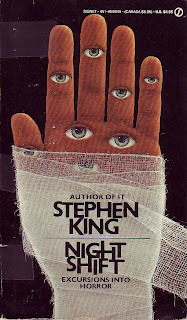
"Springheel Jack" first appeared in the University of Maine's literary journal, but was later collected in King's Night Shift.
This drink is the kind that hits the spot when it’s warming up outside (even if it’s the warmth of a false spring). And strawberries get a starring role — here in a shrub, an easy-to-make concoction of fruit, sugar and vinegar. The shrub, which you’ll need to start on the day before, lends the drink a sweet and sour character not unlike the nostalgia King evokes in the story.
Be warned, though, after a few Springheel Jacks, you too may become lost in a fog.
THE SPRINGHEEL JACK
3 oz. bourbon
1 oz. strawberry shrub (see instructions below)
½ oz lime juice
Fresh mint leaves
1 tsp sugar
Place 6-8 mint leaves in the bottom of a pre-chilled, 12-ounce cocktail glass. Add sugar and bruise the leaves with a muddler to release their flavor. Pack the glass with ice and pour in the bourbon and shrub. Stir briskly until the glass gets frosty. Garnish with a mint sprig.
To make the shrub:
Cut up a cup of strawberries and mash in a bowl. Pour a cup of granulated sugar over them and stir until the fruit and sugar are well integrated. Cover and place in the refrigerator overnight. The next day, add the contents to a saucepan, along with a cup of red wine vinegar. Cook over medium-low heat until the sugar dissolves. Do not bring to a simmer, as you’re just looking for enough heat it to make sure the sugar is no longer grainy. Strain through a fine mesh strainer into a glass storage vessel and allow to cool. Use the leftover mashed strawberries on your breakfast toast or over ice cream.


